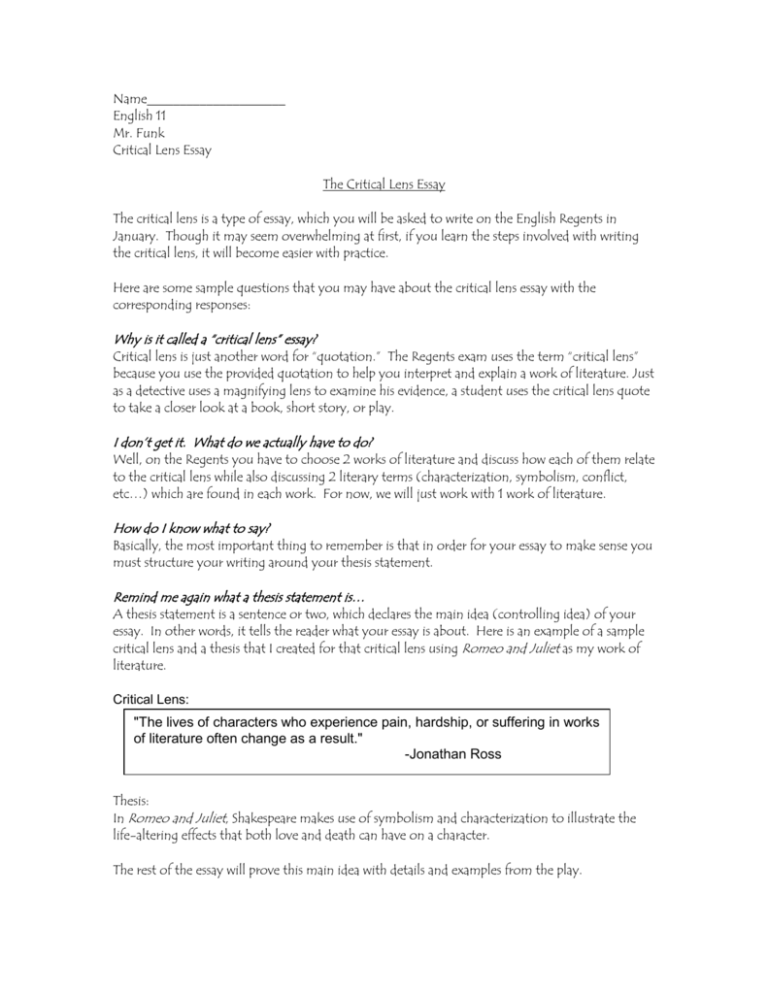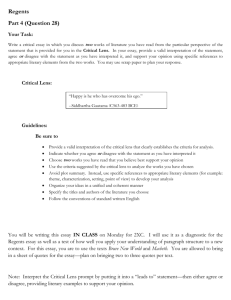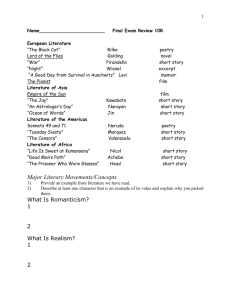Critical Lens Introduction
advertisement

Name_____________________ English 11 Mr. Funk Critical Lens Essay The Critical Lens Essay The critical lens is a type of essay, which you will be asked to write on the English Regents in January. Though it may seem overwhelming at first, if you learn the steps involved with writing the critical lens, it will become easier with practice. Here are some sample questions that you may have about the critical lens essay with the corresponding responses: Why is it called a “critical lens” essay? Critical lens is just another word for “quotation.” The Regents exam uses the term “critical lens” because you use the provided quotation to help you interpret and explain a work of literature. Just as a detective uses a magnifying lens to examine his evidence, a student uses the critical lens quote to take a closer look at a book, short story, or play. I don’t get it. What do we actually have to do? Well, on the Regents you have to choose 2 works of literature and discuss how each of them relate to the critical lens while also discussing 2 literary terms (characterization, symbolism, conflict, etc…) which are found in each work. For now, we will just work with 1 work of literature. How do I know what to say? Basically, the most important thing to remember is that in order for your essay to make sense you must structure your writing around your thesis statement. Remind me again what a thesis statement is… A thesis statement is a sentence or two, which declares the main idea (controlling idea) of your essay. In other words, it tells the reader what your essay is about. Here is an example of a sample critical lens and a thesis that I created for that critical lens using Romeo and Juliet as my work of literature. Critical Lens: "The lives of characters who experience pain, hardship, or suffering in works of literature often change as a result." -Jonathan Ross Thesis: In Romeo and Juliet, Shakespeare makes use of symbolism and characterization to illustrate the life-altering effects that both love and death can have on a character. The rest of the essay will prove this main idea with details and examples from the play. What do I say in my introduction? Just remember S.E.A.L.T. State the quote Explain the quote Agree or disagree with the quote Linking Statement Thesis Here is a breakdown of what that means. 1. “State the quote” means exactly what it sound like it does. Just rewrite the quote. 2. “Explain the quote” means put the quote into your own words. 3. “Agree or disagree with the quote” is also very simple. Just state whether you agree with the critical lens or not and why. 4. “Linking statement” connects the critical lens with whichever work of literature you are writing about. In this case, you will be writing about Romeo and Juliet. 5. “Thesis” is explained above. Annnnd…here is an example of an introductory paragraph for the quote I presented earlier: Sample Introduction Jonathan Ross once said, "The lives of characters who experience pain, hardship, or suffering in works of literature often change as a result." This means that when a character in literature experiences a major crisis, the character’s entire life can change, as a result. This is true because the experiences of a person shape their personality. In William Shakespeare's Romeo and Juliet, the characters face the consequences of a forbidden love. Unfortunately, for the young lovers, the consequences are deadly. In Romeo and Juliet, Shakespeare makes use of symbolism and characterization to illustrate the life-altering effects that both love and death can have on a character. So, hopefully you now have a better idea of what the critical lens essay is and how it is written. Be sure to ask questions about any of the above information that you still find confusing and stay tuned for more!









